Magic’s original art has finally found a foothold in the collecting community. It has finally happened. When I started writing about the more flavorful side of the game, back in 2011, original art’s average cost was $200 to $400. Of course, the playability of the card meant these values were the floor for art, with higher-valued cards played in Vintage and Legacy skewing into the thousands for highly-sought-after pieces. Even then, those pieces were really rare, and the artists who made them were all but impossible to reach. It’s funny to even think of a time when artists didn’t use social media.
Upon beginning my Alpha Art Project in 2011, multiple Alpha original artworks sold on eBay for only $1,000. Since writing, that pricing floor doubled, then doubled again. Alphas now have a base price of about $4,000 on the open market.
Then, I see this.
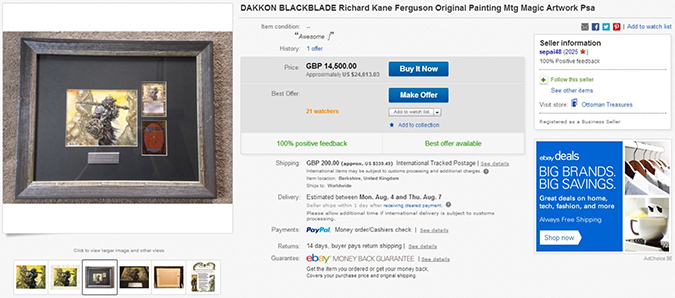
That’s $25,000 for the original art to Dakkon Blackblade. And I’m here to tell you that it’s appropriately priced. It’s just not appropriately priced for you. The art market doesn’t bend to preference or even quality. It’s all demand, and that has been irrevocably increased.
Recently—in Magic game time—OriginalMagicArt.com started posting galleries of artworks by users.
A community was being made, fueled by the forums on TheManaDrain.com’s epic two-hundred-ninety-two-page post aptly named “Magic Original Art” found in this vein:
Serious collectors discuss new art that’s come out, and there’s even a collector “wants” section, where people list their proverbial grails to find and narrow preferences. Think of it as the person who collects only angels or Terese Nielsen cards in your playgroup. It’s the same—except it’s more money, and a longer wait is involved. It’s a pretty welcoming community, in the grand scheme of things, if people are reasonable what to look for off the bat.
For example, asking where the original art of Llanowar Elves from Alpha is located is comical, as any pre-1995 art is basically attainable only with Scrooge McDuck amounts of cash. Remember the Alpha $4,000 work I mentioned? That floor is really only for damaged Alphas, and other pieces on eBay haven’t surfaced in nearly a year. Even Alpha “transfer drawings,” not even the original sketches, are hitting nearly $1,000. It’s not madness, it’s pent-up demand:

This surfacing of the Vorthos who appreciates art has always existed. What is new is that real money—serious money—is now the standard to be included in the original-art game. Christopher Moeller, whose agent is Tom Fleming at Fanfare Games, recently sold an artwork for over $10,000 on eBay. This art will only be used for Magic Online; it will never hit a physical card, and yet, the prominence of the card Bazaar of Baghdad—a card used in Dredge decks—drove a painting into the five-figure range. Now, most of Moeller’s work is pretty reasonable. Maybe there’s a $1,000 piece or two, but you can easily buy something for $250 that’ll be great for your Magic cave.

The Mana Drain and Facebook Groups
 What Moeller’s Bazaar did was as a result of an incredibly low supply of high-end Magic art—and of frenzied bidding. A silent auction with no one hearing about it raises $0. When a forum, Twitter, and prominent Vorthoses begin discussing artworks, it allows thousands of eyes and ears to hear about any high-end artwork hitting the market. Nothing slips by anymore. Three years ago, artworks could hit eBay, and they could be bought on the cheap if people were quiet about it.
What Moeller’s Bazaar did was as a result of an incredibly low supply of high-end Magic art—and of frenzied bidding. A silent auction with no one hearing about it raises $0. When a forum, Twitter, and prominent Vorthoses begin discussing artworks, it allows thousands of eyes and ears to hear about any high-end artwork hitting the market. Nothing slips by anymore. Three years ago, artworks could hit eBay, and they could be bought on the cheap if people were quiet about it.
That no longer happens.
This process really sped up with Chris Rahn having the commission for the Magic Online Black Lotus. That auction hit $16,099, and the coverage for it was incredibly high for a single auction of an artwork. It being for a seminal card in the game and the only other official Black Lotus picture were to blame, but it also set a bar.
It set the bar as Chris Rahn being the Magic artist. He’s had a few other “great” commissions and eBay auctions to boot. Good for him.

Chris Rahn is a bit unique, receiving commissions for high-profile cards and selling them when the iron was hot: right during the set’s release. But even he doesn’t hit home runs every time on public auctions. Art collectors are fickle, and the artworks will always be influenced by how often players use the card. Is it a common card but used in many decks? The value increases. Even sideboard cards will feel this effect unless it’s a sideboard card for Vintage—which would mean it’s relevant forever.
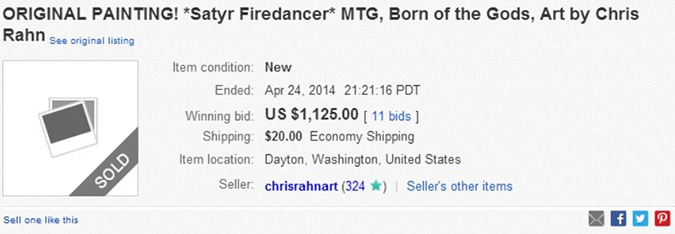
Once you get that boulder moving, it’s mighty hard to stop it. Other artists are feeling the effects of painting traditionally if they’re serious-quality artists like our boy Matt Stewart here:
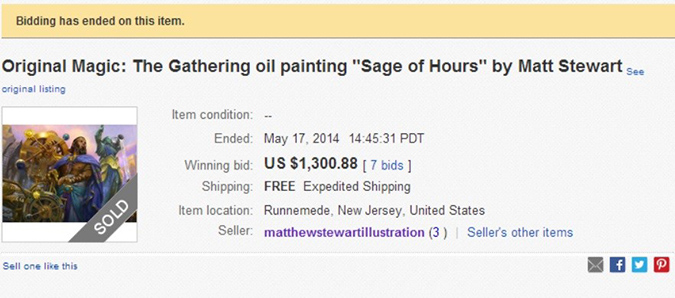
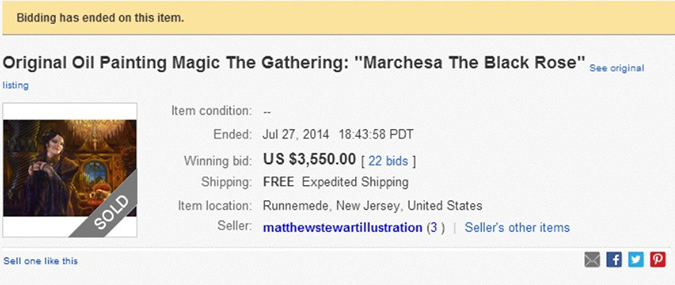
So I find it comical when new writers or Tumblr users comment on how the art was so much better “back then” or that “everything is digital now.” It’s a shortsighted comment, and frankly, it’s wrong.
With over ten thousand artworks, cherry-picking to push an agenda is super-common. Using examples doesn’t illustrate much because for every Chris Rahn, selling paintings for crazy money, I see tangible examples that show a ton of original art going unsold. Some original art will always be traditional, and yes, some original artworks are selling for thousands of dollars. But not all art is selling like hotcakes. Search “MTG original art” on eBay, and see the same works posted and reposted for months to years. It’s heartbreaking.
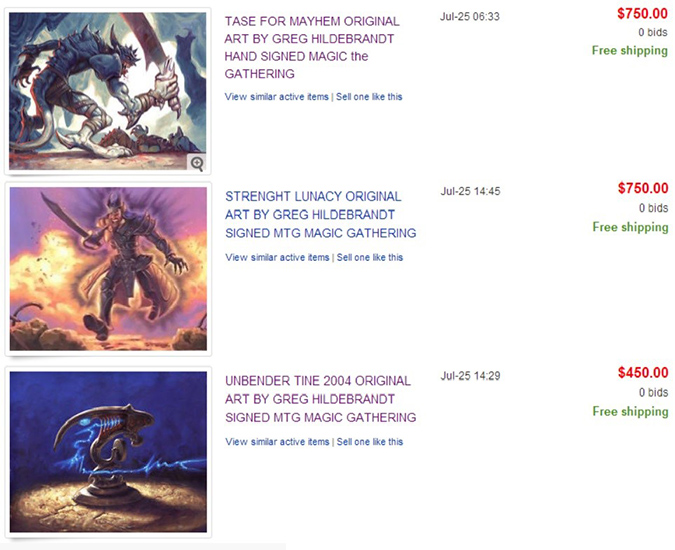
What the discussion should shift to is how artists like Matt and Chris are skewing the market, and while some artists are making off like bandits, others are getting killed because they’re either pricing themselves too low or are impossibly high, and they will only sell one or two super-played rares while the other pieces collect dust.
It begs the questions, Is this Venters piece worth nearly $3,000 or is it undervalued at $3,000 because of so many other auctions happening at the same time, forcing collectors to focus? Did Chris Rahn’s $16k Black Lotus hit crazy levels because there weren’t two or three other options happening simultaneously?

I looked into our pals at Original Magic Art (OMA) to see why.

At OMA, they have a marketplace where collectors and, more importantly, Magic artists can post their original paintings with pricing. Some artists have four pieces for sale, and others have dozens or more! Of the over seven hundred original, painted artworks (no sketches) listed on Original Magic Art’s marketplace, the average price is $773.18. If you take away the top five prices, you still are at $753.64.
This means that the average Magic artworks is now “valued” at two to four times what it was only three years ago. This is just a sampling, sure, but artists have taken note. This is like when you speculate on Daybreak Ranger and people actually start paying attention to and playing Daybreak Ranger.
In the past year alone:
- We have seen the first $2,000 basic-land purchase.
- We have seen over ten $10,000-and-higher original artworks to be purchased at public auction.
- We have seen hundreds of $100 to $400 artworks be sold and change hands to fuel more expensive art purchases.
- We have also not seen the extent of art pricing correcting itself; the prices are edging higher.
- We have seen collectors search for each others’ “grails” and be successful doing so.
- We have found villains and heroes in the art-collecting game.
- We have also seen the heartbreaking reality of asking prices to selling prices:
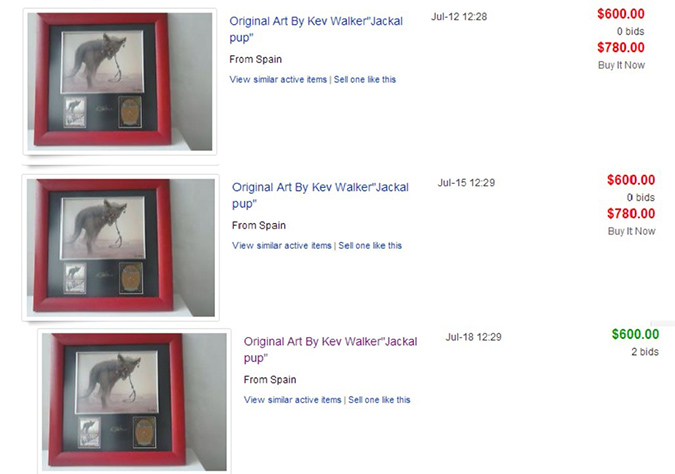
In short, remember:
- Original-art pricing hasn’t hit its ceiling, nor has it found its floor.
- Comparing Magic art to comics or book covers is a noncomparison. Book covers don’t become relevant again with newer book releases as an older card can.
- The average price is about $750 for an artwork. Paying for art over three months is quite common.
- Your favorite artwork is probably digital, and your second-favorite art is probably still owned.
- I can help you on your path to owning art; just ask me at @VorthosMike.
- If you have ever thought about buying Magic original art, I would do so immediately. You may not have the chance to do so next year. The prices aren’t going down.
- If you buy art only to immediately resell it, you won’t be buying art long. The community is small, and “flipping” is highly discouraged. Why? With every shipment of an artwork, it risks being damaged. I’ve seen images.
- Don’t skimp on framing. If your art isn’t protected from UV rays, its value plummets.
- Art in the 1990s was no larger than a scanner. They had to make it small enough to be scanned! Remember that!
- Follow me on Twitter; I always post when there’s a high-profile auction on eBay or with a private seller. Staying informed goes a long way!
Good night, and good luck.
-Mike

























